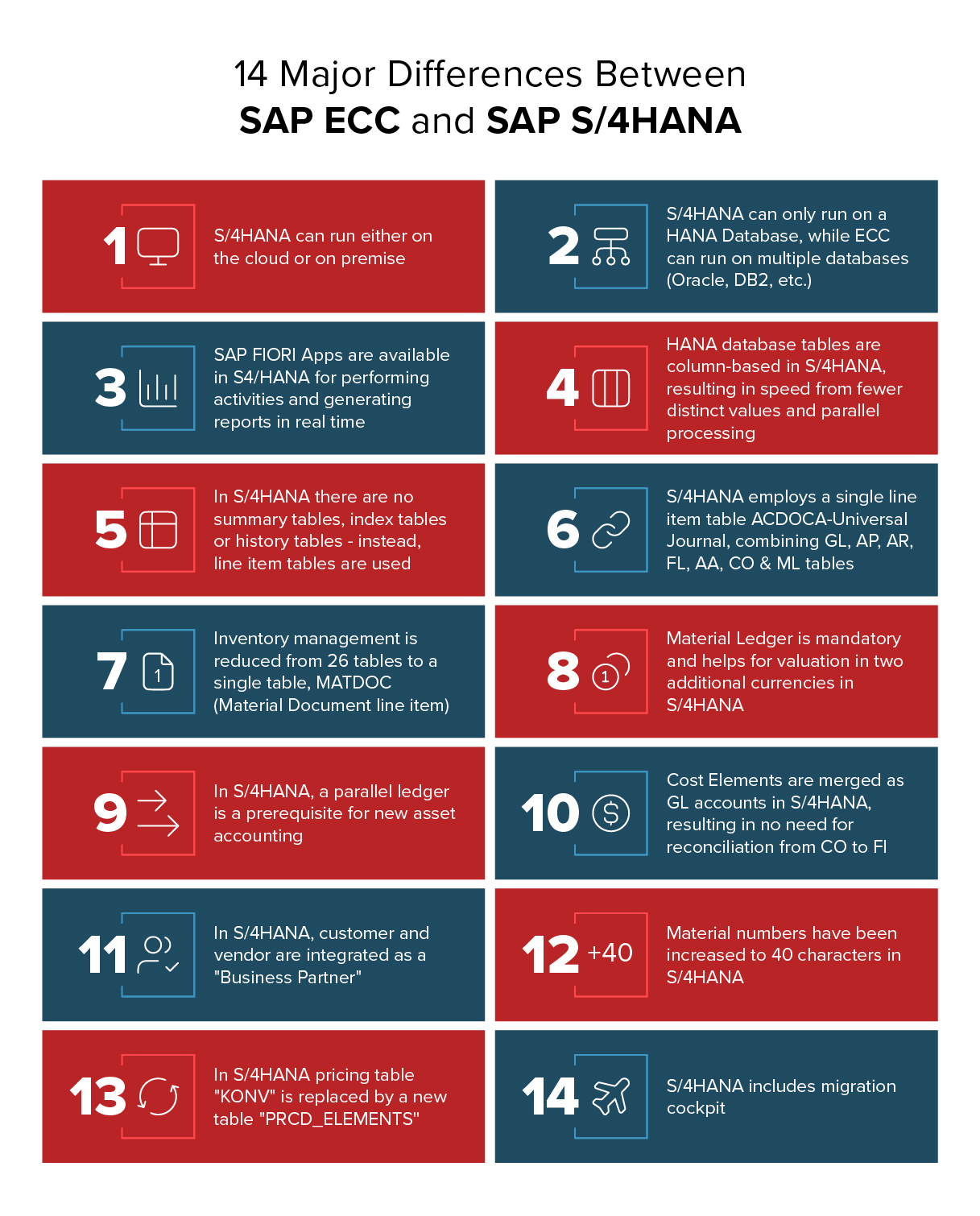Companies must be able to access, analyze, and act on data in real time to stay competitive. SAP S/4HANA is an advanced Enterprise Resource Planning (ERP) system designed to streamline operations, enhance efficiency, and support real-time decision-making. Built on the SAP HANA in-memory database, it enables instant data processing, simplifying IT landscapes and integrating technologies like AI, machine learning, and predictive analytics.
Since its launch in 2015, S/4HANA has played a crucial role in digital transformation across industries, helping businesses modernize asset management, financial operations, and overall performance. With SAP ECC support nearing its end, organizations must plan their S/4HANA migrations carefully to maximize value and minimize disruption. This article explores S/4HANA’s evolution, key benefits, deployment options, and strategies for a successful transition.
Evolution from SAP ECC
SAP ECC (ERP Central Component) has historically been the foundation of enterprise resource planning for businesses worldwide. It has supported core business functions such as finance, supply chain management, human resources, and procurement. However, as technology advances and business demands shift toward real-time insights, automation, and cloud integration, the limitations of SAP ECC have become more apparent.
To address these challenges, SAP introduced SAP S/4HANA, a next-generation ERP solution designed to simplify IT landscapes, enhance performance, and provide real-time analytics. With SAP ECC support set to end by 2027, organizations must plan their migration to S/4HANA to remain competitive and avoid operational disruptions.
SAP ECC vs SAP S/4HANA
The transition from SAP ECC to SAP S/4HANA marks a significant technological shift. Key differences include:
- Database: SAP ECC can run on third-party databases, whereas SAP S/4HANA exclusively runs on the SAP HANA in-memory database, enabling faster processing and analytics.
- User Interface: SAP S/4HANA features a modern, intuitive UI with SAP Fiori, enhancing user experience.
- Data Model: S/4HANA simplifies data structures by eliminating redundancy and reducing the need for multiple database tables.
- Process Optimization: Many traditional ECC processes have been redesigned in S/4HANA for efficiency, incorporating automation and AI-driven insights.

Key Benefits and Features of SAP S/4HANA
SAP S/4HANA is designed to drive efficiency, agility, and innovation across enterprise operations. By leveraging an in-memory database, advanced analytics, and a simplified data model, it enables organizations to process large volumes of data quickly, gain real-time insights, and optimize workflows. Below are the key benefits and features that set SAP S/4HANA apart.
Enhanced Performance and Speed
One of the most significant advantages of SAP S/4HANA is its improved processing speed, powered by the SAP HANA in-memory database. Unlike traditional databases that rely on disk storage, S/4HANA processes data in memory, enabling businesses to execute transactions and generate reports much faster.
- Reduces system latency, leading to quicker response times for business operations
- Accelerates batch processing, allowing businesses to handle high transaction volumes more efficiently
- Improves user experience by minimizing delays in retrieving and processing critical business data
With faster data access and processing, businesses can optimize their workflows, enhance productivity, and improve decision-making across departments.
Real-time Data Processing
SAP S/4HANA enables businesses to transition from batch-driven operations to real-time analytics. This means organizations can analyze vast amounts of data instantly, without waiting for overnight processing or scheduled reports.
- Provides up-to-the-minute financial and operational insights for better strategic planning
- Enables predictive analytics, allowing organizations to anticipate trends and take proactive measures
- Enhances supply chain and inventory management by delivering real-time visibility into stock levels, procurement, and demand forecasting
Real-time data capabilities empower businesses to be more agile, responsive to market changes, and better equipped to meet customer demands.
Simplified IT Landscape
SAP S/4HANA introduces a streamlined data model that reduces complexity and improves system efficiency. Unlike SAP ECC, which relies on multiple aggregate and index tables, S/4HANA consolidates data structures, eliminating redundancies and simplifying workflows.
- Fewer tables, less maintenance: The simplified architecture reduces the need for complex database administration and improves system performance
- Seamless cloud adoption: SAP S/4HANA is designed for hybrid and cloud-based environments, making it easier for businesses to transition to cloud computing and take advantage of SaaS models
- Better integration with emerging technologies: The modern architecture supports AI, machine learning, IoT, and advanced analytics, helping businesses stay ahead in digital transformation
By simplifying IT infrastructure, organizations can lower total cost of ownership (TCO), reduce system maintenance efforts, and enhance scalability for future business growth.
Differences Between SAP S/4HANA and SAP HANA
SAP HANA and SAP S/4HANA are closely related but serve distinct purposes within an enterprise IT ecosystem. While SAP HANA is the underlying database technology, SAP S/4HANA is a comprehensive Enterprise Resource Planning (ERP) suite that leverages SAP HANA’s high-speed data processing capabilities. Below, we break down their key differences.
Underlying Technologies
SAP HANA is an in-memory database designed to handle large data volumes with high-speed processing. It enables organizations to run complex analytics, process transactions in real time, and support high-performance computing across various applications.
Key Differences in Technology:
- SAP HANA: Primarily a database that supports real-time analytics and high-speed transactions
- SAP S/4HANA: A full-fledged ERP suite that runs exclusively on SAP HANA, optimizing business processes with built-in intelligence and automation
Application Use Cases
SAP HANA is a general-purpose high-performance database that supports a variety of SAP and non-SAP applications. It is commonly used for:
- Business intelligence and real-time analytics
- High-speed transaction processing
- Data warehousing and big data applications
SAP S/4HANA, in contrast, is a business solution tailored for enterprise resource planning. It provides tools for:
- Financial management and accounting
- Supply chain and asset management
- Procurement, sales, and manufacturing optimization
Integration Capabilities
Both SAP S/4HANA and SAP HANA support integration with various business applications, but they serve different roles in an enterprise IT environment.
- SAP HANA functions as a high-performance database that integrates with a wide range of SAP and non-SAP applications. It provides a foundation for advanced data processing, analytics, and transaction management. Businesses can use SAP HANA as a database for their existing ERP systems or other enterprise applications.
- SAP S/4HANA, as a next-generation ERP system, offers deeper process-level integration with SAP solutions like SAP Ariba, SAP SuccessFactors, and SAP Concur, as well as third-party tools. It includes pre-configured APIs for cloud and on-premises applications, making it easier to connect with Internet of Things (IoT) devices, Artificial Intelligence (AI) models, and Machine Learning (ML) solutions to enhance automation and predictive analytics.
Deployment Options for SAP S/4HANA
SAP S/4HANA offers multiple deployment models to meet the diverse needs of businesses, ranging from full control over infrastructure to cloud-based flexibility. Choosing the right deployment option depends on factors such as data security, compliance requirements, IT resources, and scalability needs.
On-Premises Deployment
An on-premises S/4HANA deployment involves hosting the ERP system on a company’s own servers, providing full control over data security, system customization, and compliance. This option is well-suited for organizations that operate in highly regulated industries such as utilities, pharmaceuticals, and finance, where strict data governance and security policies must be adhered to.
Cloud Deployment
SAP S/4HANA Cloud provides an agile, cost-effective alternative to traditional on-premises deployment. Managed by SAP, this option allows businesses to access S/4HANA as a service, eliminating the need for on-site infrastructure and reducing IT maintenance burdens.
Hybrid Models
A hybrid S/4HANA deployment combines elements of both on-premises and cloud models, offering a flexible solution that balances security, performance, and scalability. This approach allows companies to retain critical workloads on-premises while leveraging cloud capabilities for innovation, analytics, and scalability.
Prometheus Group Resources on SAP S/4HANA
A successful SAP S/4HANA implementation relies on accurate, well-governed master data. Without a strong foundation in data quality, organizations face inefficiencies, compliance risks, and increased operational costs. That’s where Prometheus Group comes in.
Prometheus Group’s SAP Master Data Governance (MDG) solutions help organizations streamline and automate data management processes, ensuring accuracy, consistency, and compliance across all master data objects. Whether it’s eliminating duplicate records, optimizing maintenance workflows, or simplifying mass data uploads, our solutions provide the tools needed to enhance enterprise asset management and drive operational excellence.
By leveraging Prometheus Group’s pre-configured data structures, industry templates, and automated workflows, businesses can overcome the most common SAP MDG challenges—improving data governance, reducing maintenance costs, and increasing efficiency. To learn more, sign up for a free, personalized demo today.



